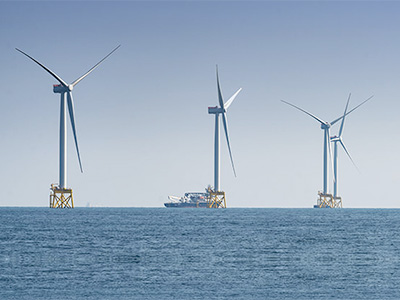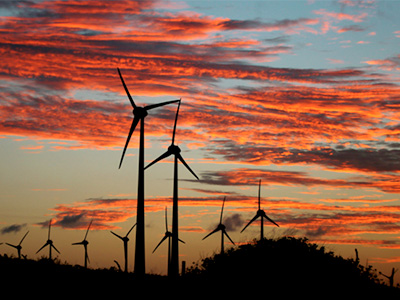Renewable energy
Iberdrola, world leader in renewable energy
We began our commitment to renewable energy more than two decades ago as the foundation on which to build its clean, reliable and smart business model.
The Iberdrola Group is today a world leader in renewable energy, with 41,303 MW of operational renewables by he end of the first nine months of 2023 and with 8,000 MW under construction, and on the cutting edge of the energy transition towards a low-emissions economy.
This commitment is reflected in our 2025 Strategic Plan, which will allocate around €17,000 million to the renewables business. Thanks to these investments, Iberdrola will increase its installed renewable capacity by 12,100 MW to 52,000 MW in 2025 - 3,100 MW of onshore wind, 6,300 MW of photovoltaic, 1,800 MW of offshore, 700 MW of batteries and 200 MW of hydroelectric -

Iberdrola. For you. For the planet.
Benchmarks in renewables with new, landmark projects
The Iberdrola Group has opened new platforms for growth to position itself in markets with massive potential for renewables and has strengthened its presence in the main countries where it operates.
It is currently building several projects which have become real milestones because of their size and innovative nature. Renewable energy is a major part of these projects and Iberdrola currently has 17 of these plants in construction or development.
Our main renewable energy projects
-
East Anglia Hub: our largest offshore wind energy project

-
Oitis, our largest onshore wind farm project in Latin America

-
Tâmega: one of the largest hydroelectric projects in Europe

-
Francisco Pizarro, the largest photovoltaic plant in Europe

-
Puertollano, the largest green hydrogen plant for industrial use in Europe

-
Port Augusta, the world's first hybrid wind-solar installation

Leaders in wind generation, also in the sea
One of the Group's main growth vectors is offshore wind. The company currently has 1.6 GW installed, rising to 3.1 GW by 2025, with construction on schedule. The company's strategy in the offshore wind segment will also be boosted in the short term by the auctions scheduled to take place in its main markets.
Learn about offshore wind energyPioneers in green hydrogen development
The decarbonisation of the planet is among the objectives that countries around the world have set for 2050. To achieve this, the decarbonisation of hydrogen —which currently accounts for more than 2 % of the world's total CO2 emissions— by producing green hydrogen, will be a major step forward. This technology is based on generating hydrogen —a universal, light and highly reactive fuel— by means of a chemical process known as electrolysis.
Discover green hydrogenLeaders in wind generation, also in the sea
One of the Group's main growth vectors is offshore wind. The company currently has 1.6 GW installed, rising to 3.1 GW by 2025, with construction on schedule. The company's strategy in the offshore wind segment will also be boosted in the short term by the auctions scheduled to take place in its main markets.
Learn about offshore wind energyPioneers in green hydrogen development
The decarbonisation of the planet is among the objectives that countries around the world have set for 2050. To achieve this, the decarbonisation of hydrogen —which currently accounts for more than 2 % of the world's total CO2 emissions— by producing green hydrogen, will be a major step forward. This technology is based on generating hydrogen —a universal, light and highly reactive fuel— by means of a chemical process known as electrolysis.
Learn about offshore wind energyWhat are renewable energies
Renewable energy is generated using natural sources that will never run out, because they contain a massive quantity of energy —such as the sun or the wind— or because they are able to regenerate fast, like biomass.
To meet growing global demand for energy and the imperative need to halt climate change, renewables are now established as the best option for the future of the energy sector. Let us tell you all about this type of energy.
The main renewable energy technologies are offshore and onshore wind, hydroelectric power, photovoltaics, green hydrogen and hybrid hydrogen.

What are the advantages of renewable energy?
Renewable energy has many advantages over non-renewable energy.


Differences between renewable and non-renewable energy
The main difference between renewable and non-renewable energy sources is that the former can produce energy indefinitely because these sources will never run out or renew themselves within a short period of time, while non-renewable energy reserves are limited because they run out when used or regenerate extremely slowly.
Another difference is that renewable energy is highly sustainable and has a very low environmental footprint, unlike non-renewables.
What are clean energy sources?
Clean energy consists of energy production systems that do not produce any pollution, notably greenhouse gases like CO2.
Therefore, clean energies are driving our progress in protecting the environment and alleviating the crisis caused by non-renewable sources, such as gas and oil.
Discover clean energyWhat are clean energy sources?
Clean energy consists of energy production systems that do not produce any pollution, notably greenhouse gases like CO2.
Therefore, clean energies are driving our progress in protecting the environment and alleviating the crisis caused by non-renewable sources, such as gas and oil.
Discover clean energy



